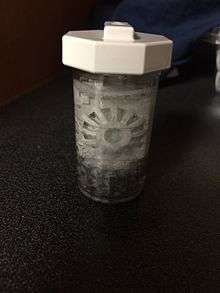Hydrogen peroxide contact solutions

Hydrogen peroxide contact solutions are storage solutions for contact lenses that rely on hydrogen peroxide to clean the contacts and break up proteins and deposits during the disinfection process.
Mechanism of action
The majority of hydrogen peroxide solutions are 3% hydrogen peroxide.[1] This enables the solution to break down any proteins that coat the contacts after a long period of use. Hydrogen Peroxide is always used alongside a neutralizing product.[2] The intention is to prevent the hydrogen peroxide from contact with the eye, which could damage the corneal cells in the epithelium. While this would not result in permanent damage, it can cause an intense burn that can linger even after an eye rinse. Burned cells heal very quickly once the natural tear film is restored.[3]
In order to prevent this damage, the solution must be stabilized before the contacts are placed into the individual's eyes. To stabilize the solution, the contacts are placed into a special container with a platinum coated disk. In solution, it gets rid of the hydrogen peroxide and produces small bubbles that help to clean the contacts. After a couple of hours, the hydrogen peroxide is stabilized and what is left is a saline solution.[4] At this point, it is safe to use the contacts. After extended use, the platinum coated disk must be replaced.
Hydrogen peroxide versus multipurpose solutions
Both hydrogen peroxide and multipurpose solutions remove debris and build-up. Significant differences exist between the two. Hydrogen peroxide has the ability to penetrate microbial films, which helps create a deeper clean. Hydrogen peroxide solutions do not contain preservatives.[5] This can be beneficial for people who are allergic or sensitive to the preservatives in multipurpose solutions. Hydrogen peroxide solutions have a greater ability to fight acanthamoeba keratitis, an infection that can cause blindness. Some researchers have found the peroxide cleaning regimen to encourage better contact lens care practices among peroxide users compared to multipurpose solution users.[6]
Multipurpose solutions tend to be less expensive.[7] Contacts do not have to be placed in multipurpose solutions for extended intervals, whereas contacts must be left in a hydrogen peroxide solution for hours. The main attraction of multipurpose solutions is that the same solution can clean, rinse, disinfect and store lenses.[8] Hydrogen peroxide solutions require a separate solution in order to rinse the contacts. Procedural mistakes put eyes at risk from contacting the hydrogen peroxide.
Types
Most hydrogen peroxide solutions cost around ten to twenty dollars. Three main name brands are available along with several generic products. The three brands are Clear Care, Oxysept, and AOsept. Clear Care is said to count for more than 80 percent of the hydrogen peroxide systems sold in the US.[9] Clear Care contains a surfactant that helps loosen debris and deposits[10] and has a platinum disk that neutralizes the solution and is good for up to 100 uses. The AOsept peroxide solution uses a disk to neutralize the solution. Oxysept is slightly different from the other two brands in that it uses tablets for the neutralization effect, which causes a slower process. The result of the tablets is a longer exposure to more concentrated hydrogen peroxide. Following recommendations to add an enzymatic cleaner weekly, increases costs.[11]
References
- ↑ "Which Contact Solution Is the Best?". Allaboutvision.com. Retrieved 2015-09-01.
- ↑ www.feelgoodcontacts.com. "Caring For Contact Lenses - Feel Good Contact Lenses". www.feelgoodcontacts.com. Retrieved 2016-09-07.
- ↑ Brimer, Crystal. "H202…What's behind the bubbles?". ModernMedicine Network. Retrieved August 31, 2015.
- ↑ "CIBA Vision Clear Care: a hydrogen peroxide based cleaner for contact lenses". Using Hydrogen Peroxide. Retrieved August 30, 2015.
- ↑ "A Guide To Cleaning Your Contact Lenses With Hydrogen Peroxide". EyeHealthWeb. Retrieved August 30, 2015.
- ↑ Sarah Guthrie, PhD; et al. "Is There a Relationship Between Care System and Compliance?". Contact Lens Spectrum. Retrieved 2016-04-14.
- ↑ Heiting, Gary. "Which Contact Solution Is the Best?". All About Vision. Retrieved August 30, 2015.
- ↑ "Your Guide to Contact Lens Solution". 1 800 Contacts. Retrieved August 30, 2015.
- ↑ Brimer, Crystal. "H202…What's behind the bubbles?". ModernMedicine Network. Retrieved August 30, 2015.
- ↑ Julita. "Difference Between AOsept and Clear Care". DifferenceBetween.net. Retrieved August 30, 2015.
- ↑ Brimer, Crystal. "H202…What's behind the bubbles?". ModernMedicine Network. Retrieved August 30, 2015.